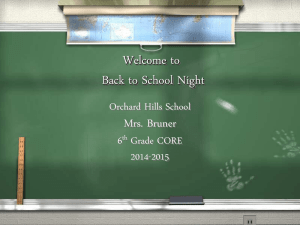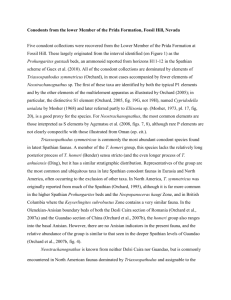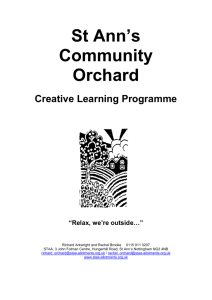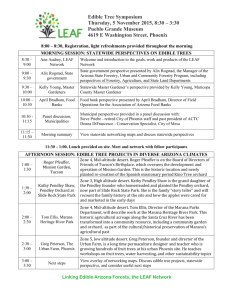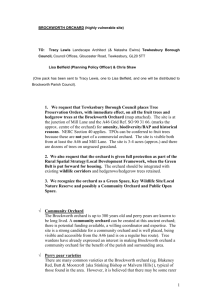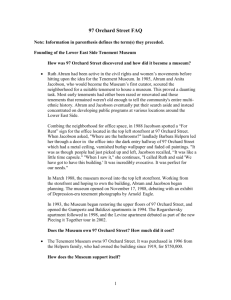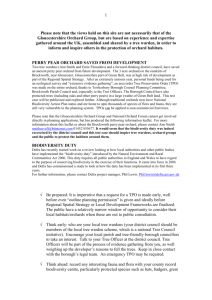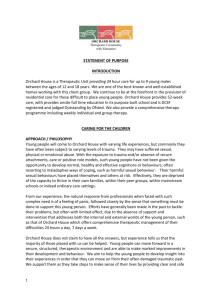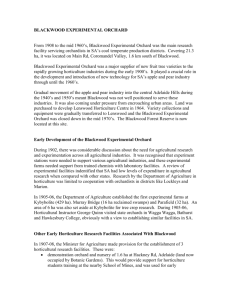Orchard - digging geography
advertisement
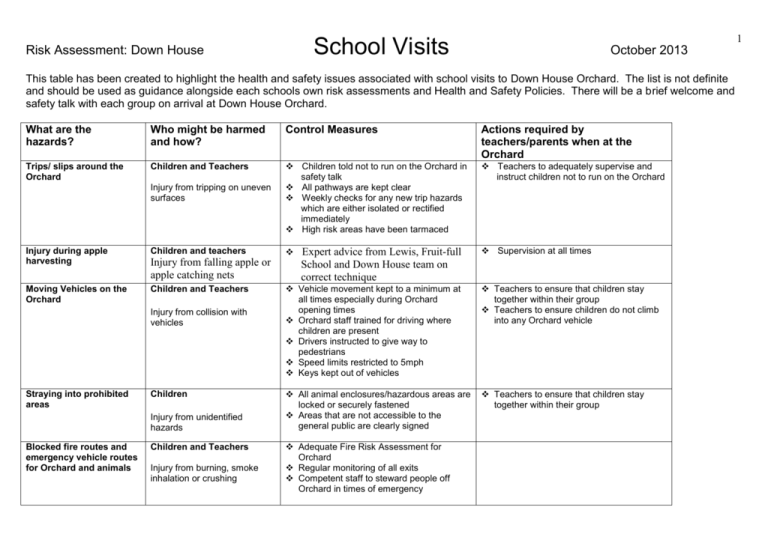
1 School Visits Risk Assessment: Down House October 2013 This table has been created to highlight the health and safety issues associated with school visits to Down House Orchard. The list is not definite and should be used as guidance alongside each schools own risk assessments and Health and Safety Policies. There will be a brief welcome and safety talk with each group on arrival at Down House Orchard. What are the hazards? Who might be harmed and how? Control Measures Actions required by teachers/parents when at the Orchard Trips/ slips around the Orchard Children and Teachers Teachers to adequately supervise and instruct children not to run on the Orchard Injury from tripping on uneven surfaces Children told not to run on the Orchard in safety talk All pathways are kept clear Weekly checks for any new trip hazards which are either isolated or rectified immediately High risk areas have been tarmaced Injury during apple harvesting Children and teachers Supervision at all times Moving Vehicles on the Orchard Children and Teachers Injury from falling apple or apple catching nets Injury from collision with vehicles Straying into prohibited areas Children Injury from unidentified hazards Blocked fire routes and emergency vehicle routes for Orchard and animals Children and Teachers Injury from burning, smoke inhalation or crushing Expert advice from Lewis, Fruit-full School and Down House team on correct technique Vehicle movement kept to a minimum at all times especially during Orchard opening times Orchard staff trained for driving where children are present Drivers instructed to give way to pedestrians Speed limits restricted to 5mph Keys kept out of vehicles Teachers to ensure that children stay together within their group Teachers to ensure children do not climb into any Orchard vehicle All animal enclosures/hazardous areas are locked or securely fastened Areas that are not accessible to the general public are clearly signed Teachers to ensure that children stay together within their group Adequate Fire Risk Assessment for Orchard Regular monitoring of all exits Competent staff to steward people off Orchard in times of emergency Risk Assessment: Down House Bees, wasps and insects Allergies If children are stung seek first aid from the nearest first aid point Injury from falls from height, cuts, bruises, breaks in limbs Safety talk tells children no climbing on fences or gates Where possible fences are designed to stop children climbing and lots of gates on animal pens have solid or mesh bottoms to prevent climbing Teachers to supervise children to ensure that they don’t climb gates/fences or other objects Children and Teachers Food containing nuts clearly labelled Teachers must be aware of which children have allergies and remove then from that environment Teachers should not allow children to eat animal’s feed. Teachers should make sure they know the guidelines about allergic reactions and what to do if someone has an allergic reaction Staff aware of the risks and instructed to point out any concerns to teachers Sun hats, sun cream, ponchos all sold in the gift shop Teachers to ensure children have appropriate clothing and footwear for the weather conditions before they leave school Correct ratios are advised Lost child policy in place Safety talk tells children to stay with their group Staff to have list of groupings and adequate adult/child ratios Periodic check of numbers, either in their groups or as a whole Count pupils on to coach and then count again (another adult) before setting off Children Risk of allergic reaction from touching animals, animal feed, straw, nuts Weather Children and Teachers Risk of sunburn, getting wet Children becoming lost 2 October 2013 These are natural inhabitants of the countryside. Bees and wasps pose no risk unless provoked Children and Teachers Injury from stings Falling after climbing gates or fences School Visits Children By lack of supervision whilst lost, leading to injury Risk Assessment: Down House Eating snacks or lunch Children and Teachers Risk of illness from contaminating food after touching animals Poor hygiene Children and Teachers From contact with harmful bacteria Pond Children and Teachers From falling into water, drowning and ingestion of contaminated water 3 School Visits October 2013 Safety talk on arrival explains importance of the children not putting their fingers in their mouths or around their faces whilst and not to eat in animal areas on the Orchard Designated eating areas are provided away from animals and indicated with adequate signage Adequate hand washing facilities around the Orchard Teachers must ensure that children wash their hands with anti bacterial soap after handling the animals and especially before eating and drinking. WET WIPES AND GELS ARE NOT SUFFICIENT Teachers ensure that food or drink is eaten only in the designated eating areas Teachers to ensure that they wash their own hands before eating, drinking and smoking and only eat, drink or smoke in the designated areas Toilet, hand washing and eating facilities provided in good condition Toilet and hand washing areas regularly checked and records kept Anti bacterial soap and paper towels provided in all toilets and hand washing areas Adequate signage on the importance of hand washing Teachers must ensure that children wash their hands with anti bacterial soap after touching animals and before eating or drinking WET WIPES AND GELS ARE NOT SUFFICIENT The pond areas are fenced off Signs warning of deep water placed round the pond area Teachers to ensure children are supervised around the pond areas Note: The figures in the Risk Rating column are: a) How likely is it to happen – 3 likely, 2 unlikely, 1 highly unlikely b) How severe might the effect be – 3 death or major injury, 2 three day illness or injury, 1 all other illness or injury c) The multiple of a and b giving figures from 1 low risk to 9 extremely high risk (1-2 low risk, 3-4 medium risk and 6-9 high risk) The figures are based on the assumption that checks and procedures are in place to reduce any risk. Created by: Martin Crabbe (adapted from Godstone Farm risk assessment) Next Review Date: October 2013



